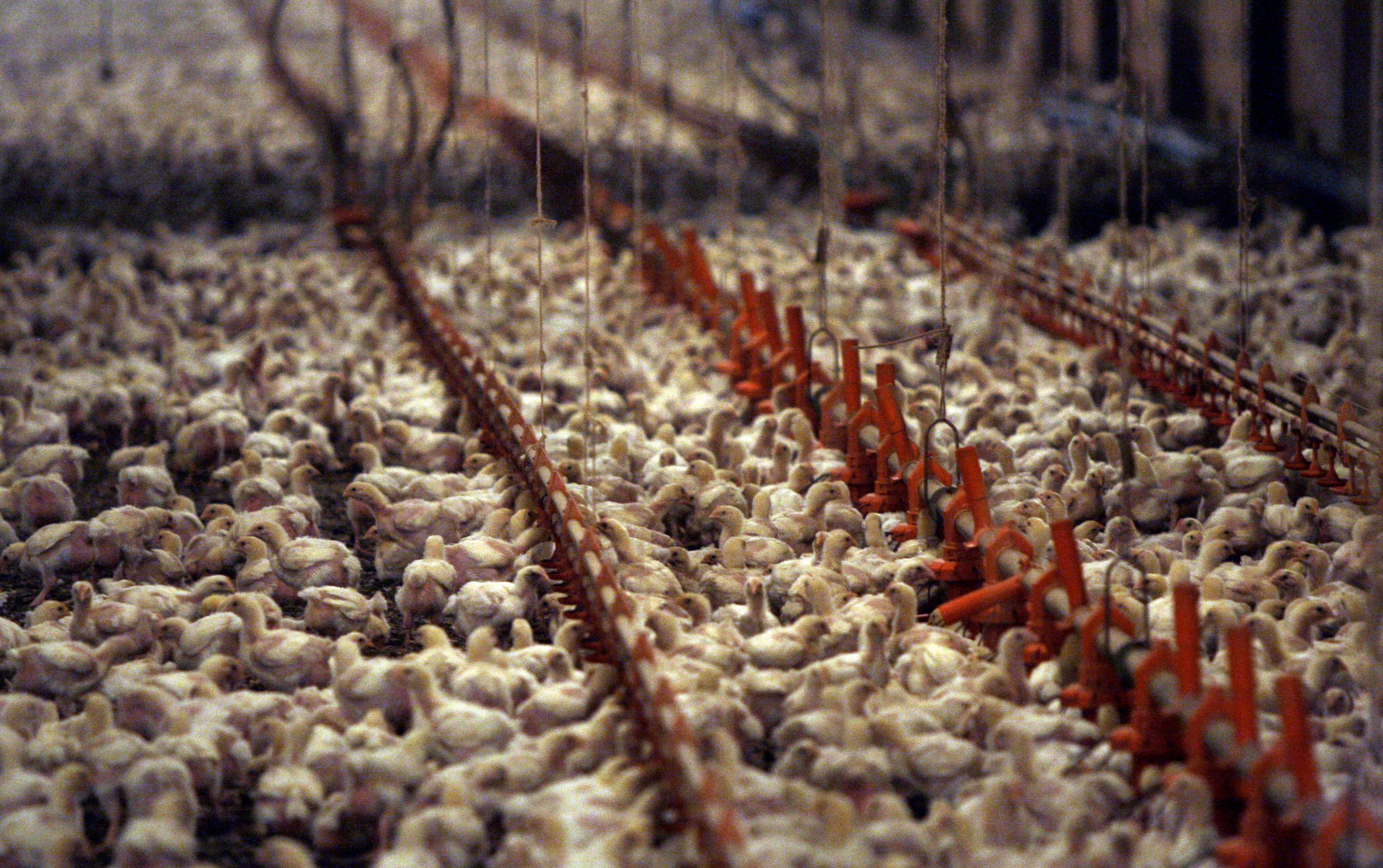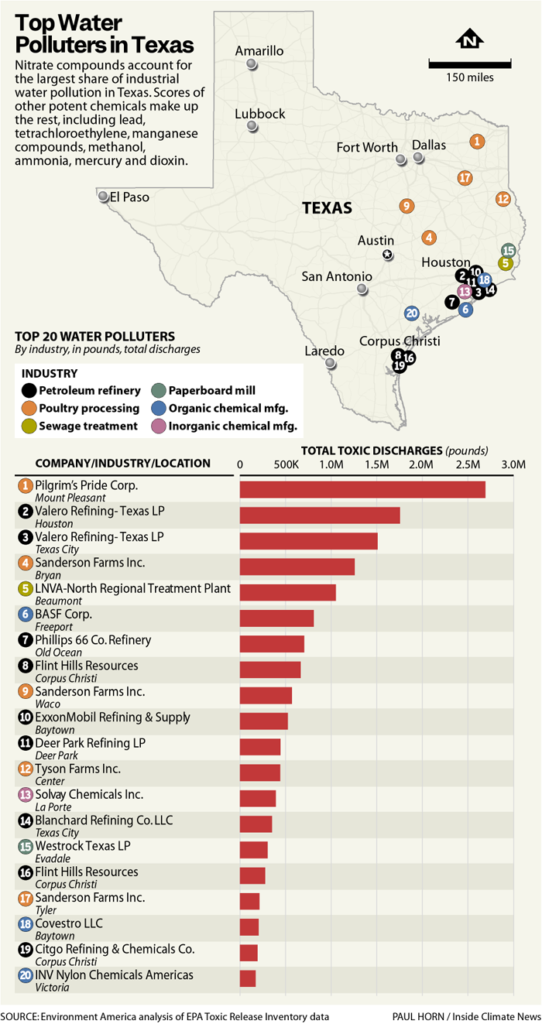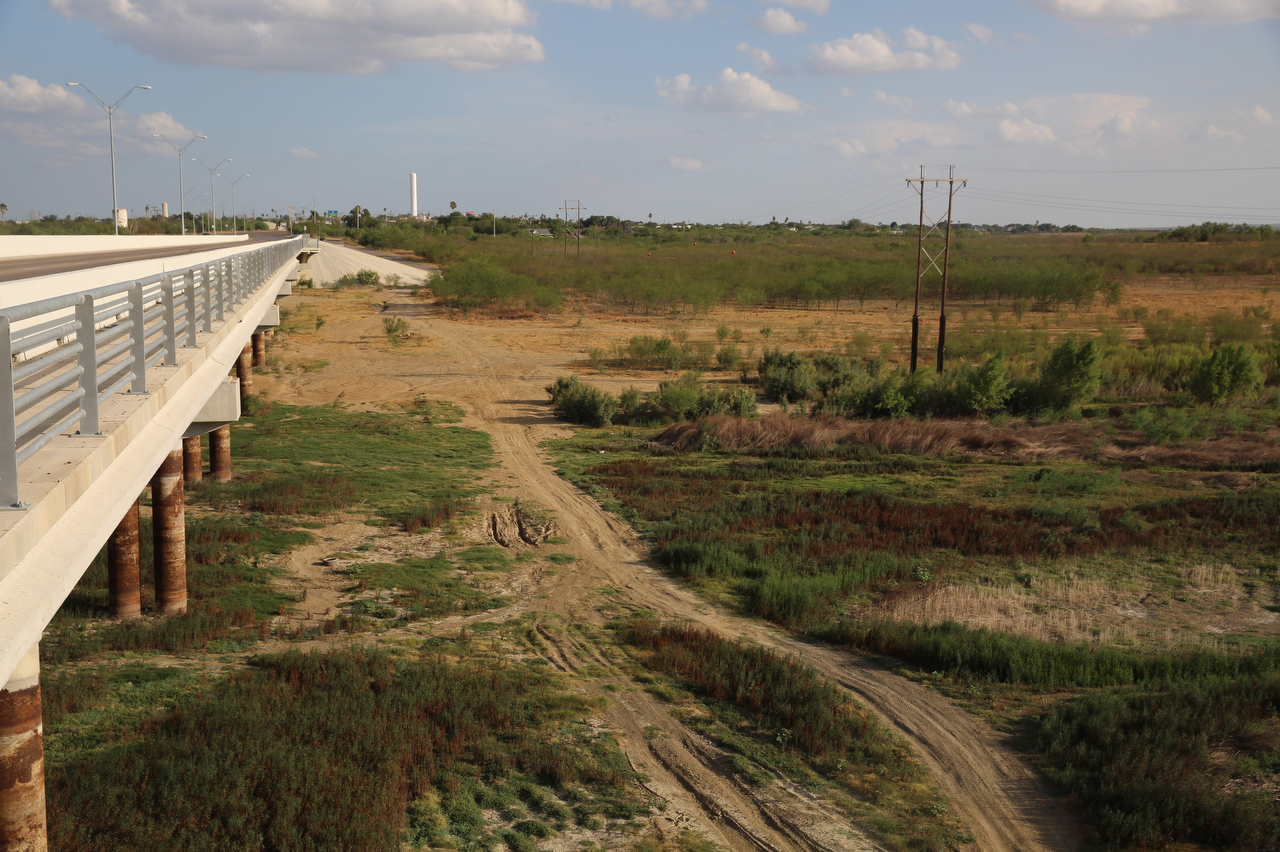
Toxic Texas Revealed
The Lone Star State now ranks number one in industrial discharges into waterways, according to a new report issued by Environment America.

This article originally appeared on Inside Climate News, a nonprofit, independent news organization that covers climate, energy and the environment. It is republished with permission. Sign up for their newsletter here.
Texas is a notably easy place to set up shop for industrial projects with lots of liquid waste and nowhere good to put it. The state’s waterways are open for business, an analysis of Environmental Protection Agency data shows, to send large volumes of discarded chemicals and industrial discharge downstream and out to sea.
In a new report by Environment America, a Denver-based nonprofit, Texas ranks first among U.S. states for toxic discharges into streams, rivers and lakes, a title held by Indiana since the organization began analyzing nationwide water pollution in 2009, when Texas ranked fourth.
The report drew from data that was self-reported by industrial facilities and logged with the EPA. It tallied 16.7 million pounds of toxic substances released into Texas water in 2020, up from 13.2 million in 2007.
“Texas has a pretty lax regulatory environment where it’s very easy to permit new polluting facilities and very difficult to get fined for violations,” said Luke Metzger, director of Environment Texas, the local affiliate of Environment America. “They know they’ll likely get away with it.”
He said penalties are low enough that companies can often still save money by flouting pollution laws and paying fines instead.
Nitrate compounds—a common component of fertilizer runoff and industrial waste—account for up to 90 percent of total toxic releases reported by industry nationwide. The rest is made up of heavy metals such as lead; solvents such as tetrachloroethylene, and manganese compounds, methanol and ammonia. It also includes small amounts of potent substances known as “persistent bioaccumulative toxics,” which build up in people and animals, including mercury and dioxin.
Many of these substances are known to make their ways from lakes and rivers to drinking water and breast milk.
To discharge industrial waste, companies file permit applications with the Texas Commission on Environmental Quality, which processes dozens of such applications each week. But Texas doesn’t provide an easy way for citizens to know exactly what industrial polluters are putting into nearby waterways. Only the EPA’s Toxics Release Inventory enables online, location-based searches for toxics released by the largest permitted polluters, based on self-reporting.
In contrast, the water pollution permit notices posted by the TCEQ for public review are more likely to cite “industrial wastewater” or “process water” rather than dive into the details of its specific toxic components. Water pollution permits do include limits for some kinds of pollutants, but the Texas data is not readily available online for just how much acetaldehyde, polycyclic aromatic compounds or polybrominated diphenyl ethers the discharge may contain.
In a statement, the TCEQ said it oversees programs “to ensure safe and effective management of pollutants that may enter Texas surface waters,” including permitting, water monitoring and compliance enforcement.
The agency “authorizes treated wastewater effluent discharges and includes a technical review and implementation procedures to ensure authorized discharges from properly operated and maintained facilities will meet Texas Surface Water Quality Standards,” it said. “Discharge authorizations also include monitoring and reporting requirements to monitor permit compliance.”
The TCEQ received 52 water quality permit applications in the last month in Harris County, Texas’ most populous county, home to Houston and the heart of the nation’s energy sector. Most of those permits were for domestic wastewater and municipal utility districts, but several came from large refineries and chemical plants in the county’s major industrial sector.
For example, one application filed by Oxy Vinyls, “a facility which manufactures polyvinyl chloride and anhydrous potassium hydroxide,” sought permission to discharge up to 105 million gallons per day, including up to two million gallons of “treated process wastewaters from polyvinyl chloride production and vinyl chloride monomer (VCM) production.” (TCEQ does offer limited searches for the status of permits.)
That waste will flow through Patrick Bayou to the Houston Ship channel, Galveston Bay and then the sea. (Patrick Bayou is already so polluted that it’s listed by the EPA as a federal Superfund site).
Of the 20 top polluting facilities in Texas identified by Environment Texas, 15 are on waterways of the coastal region, a vast expanse of former wetlands draining quickly to the Gulf of Mexico, including 13 petroleum refineries or chemical plants. The other five are poultry-processing facilities.

The top polluter in Texas is a chicken slaughter, production and frying plant in the small town of Mt. Pleasant, operated by Pilgrim’s Pride Corp, whose late founder built his French chateau on 43 acres in East Texas.
Pilgrim’s Pride is one of the top U.S. processed chicken suppliers, producing seven brands of fried and prepared chicken items, including for meals at public schools, from several U.S. facilities. Environment Texas found that in 2020 it released 2.7 million pounds of nitrate compounds into nearby Tankersley Creek, which flows to Lake O’ the Pines.
Two Valero refineries near the Galveston Bay, in Houston’s Manchester neighborhood, and another in Texas City, were the second and third top polluters in Texas, collectively accounting for 3.2 million pounds of water pollution that year, including 685,000 pounds of hydrogen cyanide, 1.4 million pounds of acrylonitrile and 22,000 pounds of 1,2,4-trimethylbenzene, according to the EPA.
Nearby in the city of Freeport, Dow Chemical Co. released 31 different chemicals into the tidal portion of the Brazos River, including 1,229 pounds of ethylene oxide and 23 pounds of hexachlorobenzene, according to the EPA.
Dow, Valero, Pilgrim’s Pride and Oxy Vinyls did not immediately respond to requests for comment sent Tuesday.
The report drew data from the EPA’s online Toxic Release Inventory, but cautioned that all the data was self-reported by industries. The polluters themselves are responsible for alerting authorities when they have committed an infraction.
In addition, many facilities release chemical waste into sewers, which isn’t included in reporting.
“As a result, the data included in this report should be understood to reveal only a fraction of what is likely a much larger and more pervasive problem of toxic discharges to waterways,” said the report, which was produced in conjunction with the U.S. PIRG Education Fund and the Frontier Group.
The report recommended a nationwide systemic reduction in the use of toxic chemicals and updates of federal pollution standards to eliminate industrial dumping in waterways.
Correction: An earlier version of this article incorrectly stated that Dow Chemical Co. released 27,000 pounds of benzene into the tidal portion of the Brazos River. The benzene was released into the air.



